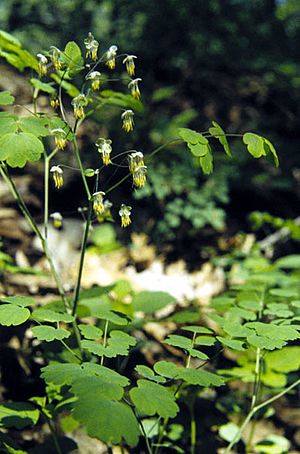Early meadow-rue facts for kids
Quick facts for kids Early meadow-rue |
|
|---|---|
 |
|
| Conservation status | |
| Scientific classification | |
| Genus: |
Thalictrum
|
| Species: |
dioicum
|
The Thalictrum dioicum, also known as the early meadow-rue or quicksilver-weed, is a type of plant in the Ranunculaceae family, which is also called the buttercup family. These plants usually grow upright. You can find them in woodlands from the Rocky Mountains in Colorado all the way to central and eastern North America, including parts of southeastern Canada.
This plant is special because it has separate male and female plants. The male plants have male flowers, and the female plants have female flowers. They bloom in early to mid-spring.
Contents
What Does Early Meadow-Rue Look Like?
The early meadow-rue grows from about 30 to 80 centimeters (about 1 to 2.5 feet) tall. It grows from a thick underground stem called a caudex, which has yellow-gold, strong, fibrous roots. Each year, a new caudex grows, and the old one slowly disappears by the next spring.
Leaves and Stems
In early spring, the plants start to grow. They produce smooth or slightly sticky leaves. These leaves grow both from the base of the plant and along the stem. They have long stems called petioles.
The leaf blades are divided into many smaller parts, often three times over. The small leaflets can be kidney-shaped, heart-shaped, egg-shaped, or round. They are usually 10 to 45 millimeters (about 0.4 to 1.8 inches) wide. Their edges often have rounded teeth. The undersides of the leaves are usually smooth or slightly sticky.
Flowers and Fruits
The flowers grow in clusters at the top and sides of the plant. These clusters can look like branched stalks or flat-topped groups. The flowers do not have petals. Instead, they have greenish sepals, which are like small leaves that protect the flower bud. These sepals are 1.8 to 4 millimeters long and sometimes have a purple tint.
On male plants, the most noticeable part of the hanging flowers are the yellow to greenish-yellow filaments. These are like thin stalks that hold the pollen. They are 3.5 to 5.5 millimeters long. At the end of the filaments are anthers, which are 2 to 4 millimeters long and hold the pollen. They have pointed tips.
After the female flowers are pollinated, they produce green fruits called achenes. Each fertilized flower usually makes 7 to 13 achenes. These fruits are small, dry, and grow in tight clusters without stalks. They are egg-shaped or oval, 3.5 to 5 millimeters long, and smooth. They have very strong veins and pointed tips (beaks) that are 1.5 to 3 millimeters long. The fruits ripen in mid-summer.
How Does It Grow and Get Pollinated?
Early meadow-rue plants are often grown in shady gardens. People like them because their leaves look delicate and lacy, similar to columbines or maidenhair ferns.
The male plants have more showy flowers than the female plants. In early spring, the flowers and leaves emerge from the ground in club-like clusters. The basal leaves (those at the bottom) unfold first. The plants start to flower even before their compound leaves are fully open.
This plant, like some other species in its group, is pollinated by wind. This means the wind carries the pollen from the male flowers to the female flowers. At the beginning of the year, male plants are usually taller than female plants. However, as the fruits grow on the female plants, the female plants typically become taller by summer.


